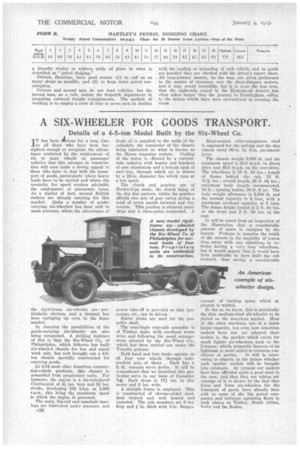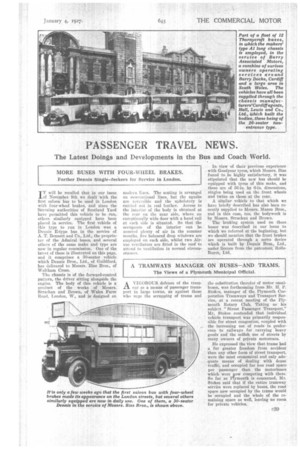A SIX-WHEELER FOR GOODS TRANSPORT.
Page 60

Page 61

If you've noticed an error in this article please click here to report it so we can fix it.
Details of a 4-5-ton Model Built by the Six-Wheel Co.
IT has been otious for a long time to all those who have been farsighted enough to recognize the advantages conferred by the employment of six or more wheels on passenger vehicles that this advance in construction will soon make a strong appeal to those who have to deal with the transport of goods, particularly where heavy loads have to be carried and where the necessity for speed renders advisable the employment of pneumatic tyres. As a matter of fact, several British makers are already catering for this market: Quite a number of goodscarrying six-wheelers has been sold to users overseas, where the advantages of
the rigid-frame six-wheeler are.particularly obvious, and a demand has been springing up even in the home market.
In America the possibilities of the goods-carrying six-wheeler are also being recognized. A striking instance of this is that the Six-Wheel Co., of Philadelphia, which hitherto has built six-wheeled chassis for bus and coach work only, has now brought out a 4-5ton chassis specially constructed for carrying goods.
As with most other American commercial-vehicle products, this chassis is assembled from proprietary units. For instance, the engine is a six-cylindered Continental of 4/ ins, bore and 51 ins. stroke, developing 102 b.h.p. at 1,800 r.p.ra., this being the maximum speed to which the engine is governed.
The main, big-end and camshaft bearings are lubricated under pressure, and c38
fresh oil is supplied to the walls of the cylinders, the remainder of the chassis being lubricated on what is known as the Myers magazine system. Cooling of the water is effected by a verticaltube radiator with header and brackets of cast aluminium and a bottom tank of cast-iron, through which air is drawn by a 26-in, diameter fan which runs at a low speed.
The clutch and gearbox are of Brown-Lipe make, the clutch being of the dry disc pattern, whilst the gearbox affords two sets of gear ratios giving a total of seven speeds forward and two reverse. This gearbox is situated amidships and is three-point suspended. A
power take-off is provided so that tyre pumps, etc., can be driven.
Spicer joints are used for the propeller shaft.
The semi-bogie rear-axle assembly is of Timken make with overhead worm drive and following the usual arrangement adopted by the Six-Wheel Co., which has been carried out under the Templin patents.
Both hand and foot brake operate on all four rear wheels through inde pendent sets of shoes. Each has a B.-K. vacuum servo device. It will be remembered that we described this particular servo in our issue of December 74. Each drum is 171 ins. in diameter and 5 ins. wide.
A straight frame is employed. This is constructed of chrome-nickel steel. heat treated and well braced and gusseted. The side members are 8 ins. deep and in. thick with 3-in. flanges.
Heat-treated silico-manganese steel is employed for the springs and the disc wheels carry 36-in, by 8-in. pneumatic tyres.
The chassis weighs 9,000 lb. and the maximum speed is 38.5 m.p.h. in direct drive and 49.5 m.p.h. on the over-drive. The wheelbase is 15 ft. 19 ins.; length of frame behind the cab, 15 ft. 11*ins. ; overall length, 25 ft. 9/ ins.; maximum body length recommended, 16 ft. ; turning radius, 30 ft. 6 ins. The body weight allowance is 2,500 lb. and the normal capacity is 4 tons, with a maximum overload capacity of 5 tons. The frame height loaded is 2 ft. 8/ inset the front and 2 ft. 10 ins, at the rear.
It will be noted from an inspection of the illustration that a considerable amount . of space is occupied by the bonnet. Perhaps in America the width of the streets in the majority of towns does away with any objections to ve-' hides having a very long wheelbase, but it would appear that it would have been preferable to have built the cab forward, thus saving a considerable amount of loading space which at ptesent is wasted.
So far as we know, this is practically the first medium-sized six-wheeler to be placed on the American market. Most of the other machines are of a much larger capacity, but even now American makers have not yet adapted their models to th,e market which exists for much lighter six-wheelers, such as the 2-tonner, which, primarily because of its lightness, is more suited to overseas con ditions of service. It will be interesting to observe in the future whether such smaller models will be brought into existence. At present our makers have been afforded quite a good start in the race, and that they are taking advantage of it is shown by the fact that 2-ton and 3-ton six-wheelers for the transport of goods have already been sold to some of the big petrol companies and railways operating fleets in such places as Turkey, South Africa, Todie and the Sudan. Part of a fleet of 12 Thornycroft buses, In which the makers' type Al long chassis Is employed, in the service of Barry Associated Motors, a combine of various owners operating services around Barry Docks, Cardiff and a large area in South Wales. The vehicles have all been supplied through the chassis manufacturers'Cardiff agents, Hall, Lewis and Co., Ltd., which built the bodies, these being of the 20-seater two entrance type.












































































































